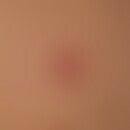DefinitionThis section has been translated automatically.
PathogenThis section has been translated automatically.
Mansonella species (nematodes of the Filariida family, in particular M. ozzardi, M. perstans, M. streptocerca). Transmission of the larvae (microfilariae) by various, mostly very small, blood-sucking mosquito species (= so-called midges). Settlement in the lymph vessels and lymph nodes, where they mature and mate. The resulting microfilariae circulate in the blood and are ingested by mosquitoes during the act of sucking. Most filariae harbor bacterial endosymbionts of the genus Wolbachia (related to Rickettsia). These are important for the immunology of the filariae themselves and for their embryogenesis, but also induce disease symptoms in the macrohost (see filariasis below).
M. ozzardi is considered a non-pathogenic or only weakly pathogenic filaria. An assessment of morbidity among 150 inhabitants of Bayeux in 1984 confirmed that there were no major medical problems due to the presence of this parasite. However, a high level of eosinophilia was closely related to parasite density (Raccurt CP et al. 2014).
You might also be interested in
Occurrence/EpidemiologyThis section has been translated automatically.
Africa and South America (Haiti). Prevalence of 10-50% in endemic areas.
ManifestationThis section has been translated automatically.
The risk of infection increases with age and can be higher in men than in women (Downes BL et al. 2010).
ClinicThis section has been translated automatically.
The disease is often asymptomatic, but can also cause fever, dizziness, myalgia, arthralgia and a feeling of coldness in the legs. Other features include neuropsychiatric symptoms, nodule formation with adult worms (in the conjunctiva or eyelids, lymphadenopathy, recurrent lymphoedema in the limbs and face (similar to the calabar swellings of Loasis), severe abdominal pain and endocrine disorders, blood eosinophilia.
Allergic reactions with pruritus, maculo-papular exanthema, urticaria, subcutaneous edema and fever are possible (see blood eosinophilia).
DiagnosisThis section has been translated automatically.
TherapyThis section has been translated automatically.
General therapyThis section has been translated automatically.
Internal therapyThis section has been translated automatically.
Therapy of 1st choice: Doxycycline 100 mg/day for 6 weeks. Combination with two single doses of ivermectin (e.g. Mectizan; only available from international pharmacies) 1 time 400 μg/kg bw p.o. at the beginning and in month 5 or 6 after the first application (blood count and transaminase control required!).
Alternatively: Albendazole (e.g. Eskazole) 2 times/day 400 mg p.o. for 10-14 days.
LiteratureThis section has been translated automatically.
Cohen JM et al. (2008) Acometimento ocular em pacientes com mansonelose [Ocular manifestations in mansonelliasis]. Arq Bras Oftalmol 71:167-171.
Downes BL et al. (2010) A Systematic Review of the Epidemiology of Mansonelliasis. Afr J Infect Dis. 4:7-14.
- Galvez Tan JZ (2003) The Elimination of Lymphatic Filariasis: A Strategy for Poverty Alleviation and Sustainable Development - Perspectives from the Philippines. Filaria J 2: 12
- Grobusch MP et al. (2003) No evidence of Wolbachia endosymbiosis with Loa loa and Mansonella perstans. Parasitol Res 90: 405-408
- Hoerauf A et al. (2001) Depletion of wolbachia enterobacteria in onchocerca vólvulus by doxcycline and microfilaridermia after ivermectin therapy. Lancet 357: 1415-1416
Raccurt CP et al (2014) Mansonelliasis, a neglected parasitic disease in Haiti. Mem Inst Oswaldo Cruz. 109:709-711.
- Wanji S et al. (2003) Epidemiology of concomitant infections due to Loa loa, Mansonella perstans, and Onchocerca volvulus in rain forest villages of Cameroon. Med Microbiol Immunol (Berl) 192: 15-21
Disclaimer
Please ask your physician for a reliable diagnosis. This website is only meant as a reference.






